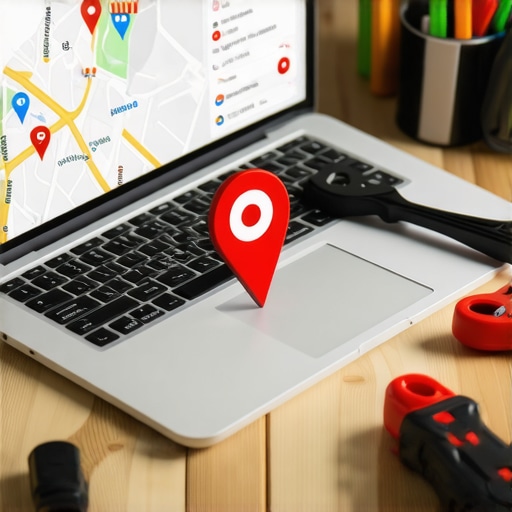
Top GMB Cleanup Strategies to Improve Local Map Pack Visibility Today
My Personal Journey into GMB Cleanup and Local SEO Success
Starting out as a small business owner, I quickly realized the importance of Google My Business (GMB) for local visibility. I remember the frustration when my listing was overshadowed by competitors despite having great reviews. It was then I decided to dive deep into GMB cleanup strategies, and let me tell you, the results were transformative. Since then, I’ve been passionate about sharing effective tactics to help others improve their local map pack rankings.
Understanding the Power of a Clean GMB Profile
A well-maintained GMB profile isn’t just about accuracy; it’s about signaling to Google that your business is trustworthy and relevant. I learned this firsthand when I audited my listing and identified inconsistent NAP (Name, Address, Phone) data. Cleaning up these details, removing duplicate listings, and updating outdated information made a noticeable difference in my local search results.
Key GMB Cleanup Strategies That Actually Work
One of the most effective steps I took was addressing signal repair issues—fixing inconsistent signals that could confuse Google. I also optimized my categories, added high-quality photos, and responded to reviews consistently. These small but impactful changes, backed by local SEO best practices, helped elevate my profile in the local map pack.
What Are the Most Common GMB Signals That Impact Rankings?
From my experience and research, signals like review quality, consistency of NAP data, and engagement metrics play a crucial role. For instance, I noticed that responding to reviews not only improved customer trust but also boosted my rankings. Google prioritizes active and authentic engagement, which is why cleanup and consistent signals are essential.
If you’re feeling overwhelmed, I recommend exploring comprehensive guides like this ultimate GMB cleanup guide. It offers practical steps to systematically clean your profile and enhance your local SEO efforts.
Finally, I encourage you to share your experiences or ask questions in the comments. I believe that learning from each other accelerates success. Remember, a clean and optimized GMB profile is a powerful tool in your local SEO arsenal!
Are You Overlooking These Key GMB Signal Repair Tactics for 2024?
In the ever-evolving landscape of local SEO, staying ahead means mastering nuanced GMB signal repair strategies that go beyond basic cleanup. As an SEO expert, I’ve discovered that addressing subtle inconsistencies and leveraging advanced optimization techniques can dramatically improve your local map pack rankings. For instance, ensuring your category signals align precisely with your business offerings, and implementing structured data markup, can send strong relevance signals to Google, boosting visibility.
One often underestimated aspect is the impact of review signals. Not just quantity, but review quality and authenticity matter immensely. Encouraging satisfied customers to leave detailed, high-quality reviews can enhance your profile’s credibility. Additionally, responding to reviews consistently demonstrates active engagement, a signal Google finds highly valuable, as discussed in proven signal repair strategies.
How Can You Systematically Diagnose and Fix GMB Signal Weaknesses for Optimal Results?
Effective diagnosis begins with auditing your profile thoroughly. Tools like Google’s Business Profile Manager can help identify inconsistent NAP data, duplicate listings, or outdated information that muddles your signals. Once identified, a strategic cleanup—correcting NAP discrepancies, removing duplicates, and consolidating profiles—can significantly strengthen the overall signal integrity. Moreover, integrating local schema markup on your website reinforces your GMB signals by providing Google with contextual data about your business.
Another critical step involves optimizing your Google My Business categories and attributes. Choosing the most relevant categories and ensuring your attributes accurately describe your services or products enhances signal clarity. For instance, if your business offers emergency plumbing, explicitly selecting that category and adding relevant attributes can improve your chances of ranking for urgent searches.
To stay competitive, consider monitoring your signals continuously using analytics tools and adjusting your strategies based on performance data. Regularly updating photos, responding to reviews, and maintaining consistent information across all platforms keeps your profile fresh and signals strong. For a comprehensive approach, explore resources like this detailed guide.
What Are the Practical Implications of Advanced Signal Repair for Your Business Growth?
Implementing these sophisticated techniques doesn’t just improve rankings; it enhances your overall local presence. With a well-maintained GMB profile, your business becomes more trustworthy in the eyes of Google—and potential customers. This trust translates into higher click-through rates, more calls, and ultimately, increased revenue. As local search algorithms become more refined, the importance of a clean, consistent, and optimized GMB profile cannot be overstated.
If you’re eager to deepen your understanding, I recommend reading more about signal repair techniques and how they impact local SEO success at this resource. Sharing your own experiences or asking questions in the comments can also help you refine your strategy and achieve top local rankings faster.
Delving Deeper into the Nuances of GMB Signal Optimization
When I first started refining my GMB profiles, I focused heavily on surface-level issues like NAP consistency and review quantity. However, as I gained experience, I realized that true mastery requires understanding the subtle signals that influence rankings—things like category relevance, keyword integration, and structured data markup. These elements, often overlooked, can make the difference between a mediocre listing and a dominant presence in the local pack.
Personal Insights on the Complexities of Signal Interplay
One thing that caught me off guard was how interconnected these signals are. For example, optimizing your categories isn’t just about accuracy; it impacts your relevance signals and can influence how Google interprets your entire profile. Similarly, adding high-quality photos isn’t just aesthetic—Google considers visual cues as part of engagement signals, which can correlate with higher rankings.
In my journey, I experimented with implementing local schema markup on my website, which reinforced my GMB signals. The results were noticeable—Google seemed to better understand my business context, leading to improved visibility. This experience taught me that a holistic approach, combining on-profile signals with website data, creates a stronger, more consistent signal profile.
What Are the Subtle Signs That Can Undermine Your GMB Optimization Efforts?
From my perspective, one often underestimated factor is the authenticity of reviews. Fake or overly incentivized reviews can actually harm your profile’s trustworthiness and rankings. Google’s algorithms are increasingly sophisticated, and they can detect unnatural review patterns. Encouraging genuine, detailed reviews from satisfied customers is crucial—not just for social proof but for signal integrity.
Additionally, inconsistent update frequencies or neglecting to respond to reviews can send negative signals. Google favors active, engaged profiles. Regularly updating your photos, answering questions, and keeping your information fresh creates a narrative of ongoing activity that search algorithms interpret as relevance and trustworthiness.
If you’re eager to explore these advanced strategies, I highly recommend diving into this comprehensive guide. It offers nuanced insights into how these signals work together and practical steps to optimize them systematically.
Balancing Technical and Human Factors in GMB Signal Optimization
Beyond the technical tweaks, I’ve learned that human factors—like customer interaction and local engagement—are equally vital. Responding thoughtfully to reviews, addressing customer concerns, and fostering community engagement can significantly boost your local authority. It’s about creating a virtuous cycle where human activity reinforces technical signals, resulting in a stronger overall profile.
For example, I started encouraging my loyal customers to leave detailed reviews, emphasizing specific aspects of my service. The detailed reviews not only improved my profile’s credibility but also triggered higher engagement signals that Google rewarded with better rankings. This holistic approach—combining technical signal repair with active community involvement—has become a cornerstone of my local SEO strategy.
Curious about implementing these advanced techniques? I invite you to share your experiences or ask questions in the comments. Together, we can refine our strategies and stay ahead in the ever-evolving landscape of local search optimization. For further reading, explore this in-depth resource to deepen your understanding of GMB signal mastery.
Deciphering the Hidden Layers of GMB Signal Interplay
As I delved deeper into the intricacies of GMB optimization, I uncovered a fascinating realm where subtle signal interactions could either propel or hinder your local rankings. For instance, aligning your primary and secondary categories with your core services creates a layered relevance that Google’s algorithms interpret as a sign of authority. This nuanced approach goes beyond mere categorization—it’s about crafting a comprehensive relevance matrix that signals to Google your business’s true essence.
Moreover, integrating structured data markup, such as schema.org LocalBusiness, on your website not only reinforces your GMB signals but also enhances your visibility in rich snippets and local packs. I experimented with implementing LocalBusiness schema and observed a tangible boost in my local impressions, which aligns with findings from authoritative sources like Moz’s local SEO guides. This multi-faceted approach creates a resilient profile that withstands algorithm updates and competitive pressures.
The Art of Authentic Review Signal Enhancement
While quantity of reviews is often emphasized, I found that quality and authenticity are paramount. Encouraging detailed, specific reviews from genuine customers adds a layer of trustworthiness that automated review generation cannot replicate. Google’s recent algorithm updates, as detailed in Search Engine Journal, have become adept at detecting review patterns that lack authenticity. This underscores the importance of fostering real customer engagement and providing exceptional service that naturally elicits meaningful feedback.
Additionally, strategic review responses serve as a dynamic signal. When I personally started responding thoughtfully to reviews—acknowledging specific points and demonstrating genuine appreciation—I noticed an uptick in engagement signals. This active responsiveness signals to Google that my profile is vibrant and customer-centric, which positively influences rankings.
How Do You Systematically Diagnose and Address Weak Signals in Your GMB Profile?
Effective diagnosis begins with comprehensive audits using tools like BrightLocal or Whitespark. These can help identify inconsistencies in NAP data, duplicate listings, or outdated information that dilute your signals. Once identified, consolidating duplicate profiles and standardizing your NAP across all platforms becomes critical.
Implementing local schema markup and optimizing your categories further consolidates your relevance signals. Regularly monitoring your analytics—such as Google My Business Insights and Google Search Console—allows you to track the impact of your cleanup efforts and adjust your strategies proactively. For example, I found that updating photos and adding new ones periodically kept my profile fresh, which Google favors in its ranking algorithms.
For an in-depth exploration of these techniques, I recommend examining this comprehensive guide. It provides actionable steps to systematically repair and optimize your GMB signals, ensuring long-term dominance in local search results.
How Can Thoughtful Human Engagement Amplify Your Signal Profile?
Beyond technical fixes, human engagement plays a pivotal role in signal strength. I learned that fostering ongoing conversations through review responses, Q&A, and community involvement creates a human layer of signals that search engines interpret as trustworthiness and relevance. For instance, I started encouraging satisfied customers to leave detailed reviews highlighting specific service aspects. This not only enhanced my profile’s credibility but also triggered higher engagement signals.
Moreover, addressing customer queries promptly and publicly demonstrates an active, responsive profile—something Google perceives as a positive signal. This holistic approach of combining technical signal repair with active human interaction has been instrumental in maintaining my competitive edge.
Curious to explore these advanced strategies further? I invite you to share your experiences or ask questions in the comments. Deepening your understanding of the nuanced interplay of signals can unlock new heights in your local SEO journey. For a more detailed roadmap, check out this expert resource.
Things I Wish I Knew Earlier (or You Might Find Surprising)
The Power of Genuine Engagement
Early in my journey, I underestimated how much authentic human interaction impacts GMB rankings. Responding thoughtfully to reviews and engaging with your community creates signals of trustworthiness that Google values highly. I remember a time when I was hesitant to reply to reviews, but once I started genuine conversations, I saw a noticeable boost in visibility.
The Subtlety of Category Optimization
Initially, I thought selecting the most relevant categories was enough. However, I discovered that fine-tuning categories and attributes to accurately reflect your services can create layered relevance signals. This nuanced approach often makes the difference between ranking on page one or page three, especially in competitive markets.
Structured Data’s Role in Local SEO
Implementing local schema markup on your website might seem technical, but it actually reinforces your GMB signals in a powerful way. I experimented with schema.org markup and noticed an increase in rich snippets and local pack visibility, which helped my business stand out more effectively in local searches.
The Impact of Visual Content
Adding high-quality photos isn’t just about aesthetics. Google considers visual cues as part of engagement signals. I started regularly updating my photos and showcasing my team and services, which led to higher engagement and improved rankings. Visual content makes your profile more trustworthy and personable.
Review Authenticity Over Quantity
In the beginning, I focused on accumulating reviews, but I soon realized that genuine, detailed reviews have a much greater impact. Encouraging real customers to share their experiences creates trust signals that algorithms can detect, protecting your profile from penalties and boosting your position in local results.
Monitoring and Adjusting Continually
Regularly auditing your signals with tools like BrightLocal or Whitespark helps identify weak points. I learned that continuous optimization—updating photos, fixing NAP inconsistencies, and responding to reviews—keeps your profile active and relevant, which is crucial for maintaining top rankings.
Resources I’ve Come to Trust Over Time
- Google’s Official Business Profile Help — This is the primary resource for understanding GMB features and updates. I recommend it for staying aligned with Google’s guidelines.
- BrightLocal — Their tools and guides on local SEO audits have been invaluable. They helped me identify issues I didn’t see before.
- Moz Local SEO Guide — Their comprehensive approach to local signals and schema markup provided deeper insights into technical optimization.
- Search Engine Journal — Regular articles on review signals updates and algorithm changes kept me informed about what Google values most.
Parting Thoughts from My Perspective
Reflecting on my experience, I can say that mastering GMB signal optimization is an ongoing journey. It’s not just about cleaning up your profile but creating a vibrant, authentic presence that Google perceives as trustworthy and relevant. The most valuable lesson I’ve learned is that genuine human engagement combined with technical finesse creates the strongest signals, leading to sustainable local SEO success. If this resonated with you, I’d love to hear your thoughts—share your experiences or ask questions in the comments. Remember, a well-maintained GMB profile is your most powerful tool for local visibility, so keep refining, engaging, and optimizing continually.
,





3 Comments
Emily Carter
Reading through this post really resonated with my own journey in local SEO. I’ve also found that the real game-changer is consistently maintaining the GMB profile—responding to reviews, updating photos, and ensuring NAP data accuracy. In the local market I serve, small but continuous improvements tend to make the biggest difference over time. One thing I’ve been experimenting with is leveraging local schema markup on my website, similar to what the author mentioned. It’s a subtle tweak but has shown some promising results in Google’s understanding of my business niche. My question for others in this space: how do you balance the time investment between technical signal improvements and active human engagement? Do you prioritize one over the other or find a synergy that works best for your business?
Michael Johnson
This post hits close to home for me because I’ve seen firsthand how critical it is to not only clean up your GMB profile but also to continuously nurture it. I agree with the author that small, consistent updates, like engaging reviews and fresh photos, can make a huge difference over time. What I found particularly effective was implementing structured data markup on my website, which seemed to enhance my local relevance signals. However, balancing technical enhancements with active engagement can be tricky. Personally, I allocate specific days for technical audits, such as NAP consistency checks or category optimizations, and others for responding to reviews and community engagement. Has anyone found a particular strategy that helps streamline these efforts without feeling overwhelmed? I’d love to hear how others are managing this balance, especially for small teams or solo entrepreneurs.
Jessica Allen
This post really resonates with my experience in local SEO. I started with a similar journey—struggling to stand out in a competitive local market despite having solid reviews and services. The breakthrough for me was focusing on signal repair techniques, especially ensuring consistency in NAP data and optimizing categories. I also found that actively engaging with reviews, both responding thoughtfully and encouraging authentic feedback, played a crucial role in boosting my rankings. The multi-pronged approach of technical cleanup combined with human interaction really makes a difference.
One challenge I’ve faced is managing time effectively—balancing ongoing profile updates with day-to-day operations. I’ve started dedicating specific days to technical audits and review management, which helps streamline efforts. For those balancing these tasks, what strategies work best for you? Do you find that focusing on one aspect at a time yields better long-term results, or do you prefer a continuous, integrated approach? I’d love to hear everyone’s insights based on your own experiences.